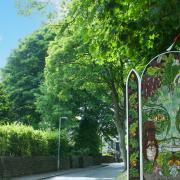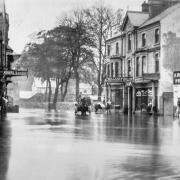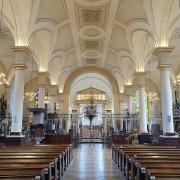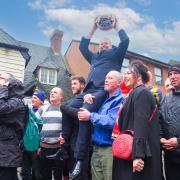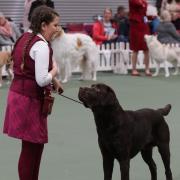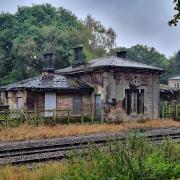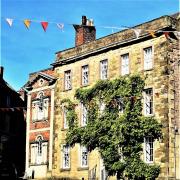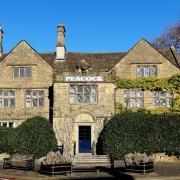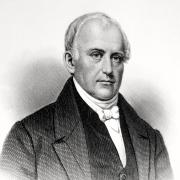When the first bricks of what would become Hagg Hill Hall were laid down, Henry VIII was on the throne and the first English translation of the Bible had just been published.
Much has changed since, yet Tupton’s Hagg Hill Hall defiantly remains, thriving like never before.
It’s thanks, in no small part, to its 81-year-old custodian Melvyn Humphreys, who has put his heart and soul into the property.
‘My mother used to say I made houses smile again,’ says Mel warmly.
I’ve always had an entrepreneurial spirit. I started as a boy soldier, became Imperial Services boxing champion and even fought for my country.
‘I lost my father when I was 19 and left the Army with no qualifications so I quicky had to apply myself. My mother was a friend of the manager of Sheffield Locarno nightclub and he believed I was the sort of lad he could use.

‘Within ten months I was, I believe, the world’s youngest ballroom manager. That was my introduction to the leisure business.’
Twenty-two cities and 27 businesses later, a new occupation – one he counts as his true passion in life – presented itself.
‘When I got to 35 I asked myself whether I could see myself doing this for the rest of my life, working every bank holiday and weekend. I couldn’t see myself having a married life with children living that lifestyle,’ he says.
‘So, I changed direction. I had always loved property and started buying little terraced houses and doing them up before progressing into what I really fell in love with, period buildings and houses. I’ve dedicated the past 45 years of my life to it.’
For all the buildings that benefited from Mel’s expertise and passion, it’s Hagg Hill Hall which has defined a huge part of his life.
‘It had been on the market three years when I spotted it and it was too big a project for anyone of a sane mind to take on,’ he laughs.
‘The farm had ceased to be a working farm and all the outbuildings had become derelict.
‘Me being me, I was determined to revive it. We converted the barns into beautiful cottages and I took the main house as my residence.’
Mel beams as he tells the story of the hall’s long and fascinating history.
‘I was fortunate that within a couple of years of arriving I met David Clay, a local historian, whose family lived here for 250 years. We spent many happy hours talking about the place,’ he says.
‘The first part of the building, with the minstrel gallery, is the original bit. It was originally a cottage built in 1540 – there’s a stone date on the back of the house.
‘Most of the main house was built in 1650, so a 100-year gap. In the 1800s, a Georgian extension was put on the back, the 1900s saw the swimming pool added and in the 2000s I put the garden in, so each era has it own bit of history.
‘In the 20th century it was famous for its flower gardens and greenhouses and hosted open days for charity functions. It even had an international bowling green and was used as an auxiliary hospital during the First World War.

There isn’t a brick or wooden beam at Hagg Hill Hall that Mel doesn’t know. And, over the years, the house has revealed some fascinating secrets.
‘When we arrived, the hallway floor was totally rotten so one of the first things we did was take the floor out,’ he reveals.
‘When we did that, my workman discovered a stone slab, like a stair step. He put his shovel down the side of it and it went right down.
‘We started digging and found a stone staircase which led down to a vaulted cellar, which is subterranean.
‘In there, concealed in the wall, we found two small stone windows. So, the ground elevation outside is seven feet higher now than it was.
‘In the cellar there is a vaulted arch with a stone floor and well. We cleaned and pumped it out, put a door on it and used to let people look at it. Over the past few years we’ve had so much rain it has filled with water, so we can’t use it anymore – but it’s there.’
Another reason Hagg Hill Hall is so captivating is the sense it gives you of the people who went about their life there centuries ago.
‘We were in one of the bedrooms assessing what we needed to do it,’ remembers Mel.
‘In the corner was a hole within a wooden beam. I put my hand in and discovered an old pipe. This would have been a servant’s room. On the floor you can see remnants of a bell pull, a feature of these types of houses.
‘I imagine he would lie in bed, smoke his pipe, put it out in the hole and leave it there. It made me smile. A bit of living history.’
Hagg Hill Hall has clearly given Mel much joy over the years. Yet it’s not been all plain sailing.
‘After the kids had grown up and left I thought “what do I do now? Do I sell and downsize?” The problem was I had fallen so in love with it I didn’t want to let it go.
‘I had to make it work so I changed it into a holiday let whilst I still live in a section of the house,’ explains Mel.
‘Gradually we built it up to 100% weekend occupancy, then Covid came along. I lost £192,000 of bookings I can never get back. It’s still not easy, and it’s hard work, but we’ll get there.’
Despite the unforeseen setbacks, Hagg Hill Hall continues to have plenty going for it.
Able to sleep 22 and including an indoor heated pool, sauna, indoor and outdoor jacuzzis and an indoor BBQ hut amongst other features, it’s a fabulous mix of oldy worldly living meets luxury.
‘It’s all inclusive too,’ he says. ‘I hate it when places charge for add-ons – extra for fire logs, extra for towels… it’s not how we do things.
‘The dining room probably gets the biggest reaction, people comment that it’s like being in Downton Abbey. It’s a magical part of the house that has created many wonderful moments.’
Whilst Mel has opened his house up to guests and sympathetically transformed it into a premium holiday let, there remains something deeply personal about his connection to, and relationship with, the building.
‘From day one when it was empty and run down it was a warm, welcoming home – not a house, a home,’ he concludes.
‘I get so much pleasure from it and people take pleasure from it too; that really keeps me going.
‘It’s now a family trust and we run it as such – we make decisions as a family.
‘It’s become an important part of my life. My will even stipulates I be buried here when I’m gone.
‘I’ve got six dogs buried in the garden from my time here and I will be buried next to them. That’s what this place means to me.’








